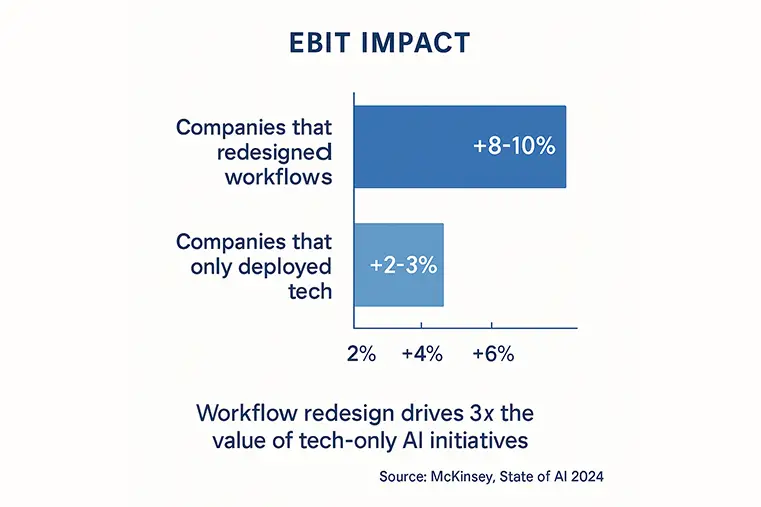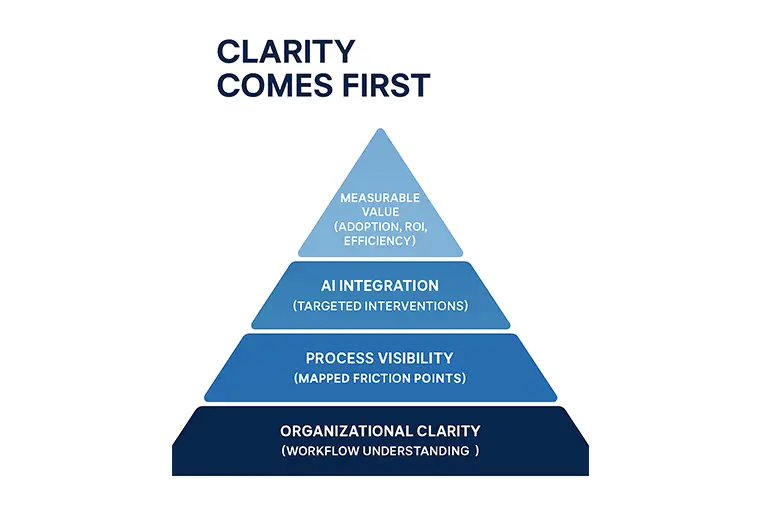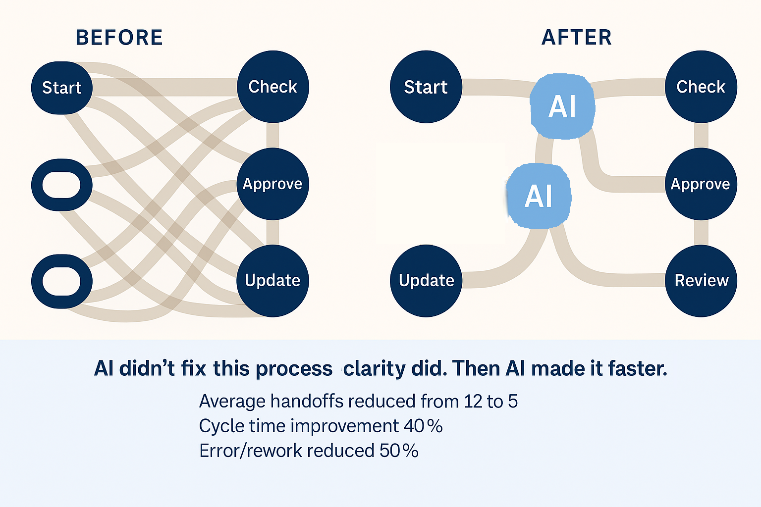
Across sectors, organizations are launching AI pilots and proof-of-concepts, but many stall out, entering the AI Graveyard, or they fail to reach scale. The missing ingredient isn’t better algorithms or smarter AI. It’s organizational clarity: knowing where AI fits, where friction lies, and where value is waiting to be unlocked.
AI does not fix broken workflows. It magnifies them.
It’s common to hear that “AI failed us.” But when you dig deeper, failure often stems from lack of context, misaligned expectations, and poor integration, not from the technology itself.
Some industry examples:

These findings support a shift: the cause of failure is less about models or infrastructure, and more about lack of clarity, context, and alignment.
Mapping workflows is not “nice to have,” it is critical to identifying where AI can drive real impact. A structured approach to visibility allows you to:
Without visibility, AI becomes a vague tool, applied in ad hoc places, disconnected from business goals.
Evident Digital argues that neglecting AI workflow readiness leads to fragmentation, inconsistent AI performance, lack of collaboration, and failure to scale. Conversely, organizations that integrate AI into thoughtfully redesigned workflows generate faster time to value and higher ROI. [5]

Most organizations start at the top of the pyramid, but success begins at the bottom.
Technology always follows understanding, and clarity is the context problem solvers depend on.
With clarity you:
When you start with clarity, you don’t ask “Where can we use AI?”
You ask, “What business needs can be supported with AI?”
That shift changes how experiments, resourcing, and adoption proceed.
In My Experience
One finance team I supported was asked to automate report generation with AI. Their intuition was “let the model write the reports.” And they tasked the AI Engineering team to create an agent to do that.
But once they mapped their process, they discovered a deeper truth: there were twelve manual handoffs and reconciliation steps before any report content existed. The bigger problem was data readiness, not manual report writing.
They first applied AI to cleaning the upstream process:
Then and only then did they apply AI to generate reports from a clean, consistent feed. The result: 40 % faster turnaround and a 50% reduction in rework. A far greater impact than they would have realized if they had started with “AI for report writing.”

Clarity changed the question. And that changed the result.
Clarity enables you to:
Clarity isn’t just a nice-to-have. It’s an operational capability. When a team can see the flow and measure progress, experimentation becomes disciplined scaling.
If your teams are still guessing where AI belongs, or you started with the AI solution and not the problem, it’s time to get clarity.
Contact me to learn how AI-Native Foundations helps leaders see their workflows and measure the value AI creates.
[1]: https://www.captechconsulting.com/articles/why-so-many-ai-initiatives-are-failing-to-deliver-roi "Why So Many AI Initiatives Are Failing to Deliver ROI"
[2]: https://www.bcg.com/press/24october2024-ai-adoption-in-2024-74-of-companies-struggle-to-achieve-and-scale-value "AI Adoption in 2024: 74% of Companies Struggle to ..."
[3]: https://www.mckinsey.com/capabilities/quantumblack/our-insights/the-state-of-ai "The State of AI: Global survey"
[4]: https://www.mckinsey.com/capabilities/quantumblack/our-insights/seizing-the-agentic-ai-advantage "Seizing the agentic AI advantage"
[5]: https://www.evidentdigital.com/blog/beyond-the-algorithm-why-ai-ready-workflows-are-essential-for-unlocking-true-enterprise-productivity "AI-Ready Workflows Drive Real Enterprise Value - Evident"












Across sectors, organizations are launching AI pilots and proof-of-concepts, but many stall out, entering the AI Graveyard, or they fail to reach scale. The missing ingredient isn’t better algorithms or smarter AI. It’s organizational clarity: knowing where AI fits, where friction lies, and where value is waiting to be unlocked.
AI does not fix broken workflows. It magnifies them.
It’s common to hear that “AI failed us.” But when you dig deeper, failure often stems from lack of context, misaligned expectations, and poor integration, not from the technology itself.
Some industry examples:

These findings support a shift: the cause of failure is less about models or infrastructure, and more about lack of clarity, context, and alignment.
Mapping workflows is not “nice to have,” it is critical to identifying where AI can drive real impact. A structured approach to visibility allows you to:
Without visibility, AI becomes a vague tool, applied in ad hoc places, disconnected from business goals.
Evident Digital argues that neglecting AI workflow readiness leads to fragmentation, inconsistent AI performance, lack of collaboration, and failure to scale. Conversely, organizations that integrate AI into thoughtfully redesigned workflows generate faster time to value and higher ROI. [5]

Most organizations start at the top of the pyramid, but success begins at the bottom.
Technology always follows understanding, and clarity is the context problem solvers depend on.
With clarity you:
When you start with clarity, you don’t ask “Where can we use AI?”
You ask, “What business needs can be supported with AI?”
That shift changes how experiments, resourcing, and adoption proceed.
In My Experience
One finance team I supported was asked to automate report generation with AI. Their intuition was “let the model write the reports.” And they tasked the AI Engineering team to create an agent to do that.
But once they mapped their process, they discovered a deeper truth: there were twelve manual handoffs and reconciliation steps before any report content existed. The bigger problem was data readiness, not manual report writing.
They first applied AI to cleaning the upstream process:
Then and only then did they apply AI to generate reports from a clean, consistent feed. The result: 40 % faster turnaround and a 50% reduction in rework. A far greater impact than they would have realized if they had started with “AI for report writing.”

Clarity changed the question. And that changed the result.
Clarity enables you to:
Clarity isn’t just a nice-to-have. It’s an operational capability. When a team can see the flow and measure progress, experimentation becomes disciplined scaling.
If your teams are still guessing where AI belongs, or you started with the AI solution and not the problem, it’s time to get clarity.
Contact me to learn how AI-Native Foundations helps leaders see their workflows and measure the value AI creates.
[1]: https://www.captechconsulting.com/articles/why-so-many-ai-initiatives-are-failing-to-deliver-roi "Why So Many AI Initiatives Are Failing to Deliver ROI"
[2]: https://www.bcg.com/press/24october2024-ai-adoption-in-2024-74-of-companies-struggle-to-achieve-and-scale-value "AI Adoption in 2024: 74% of Companies Struggle to ..."
[3]: https://www.mckinsey.com/capabilities/quantumblack/our-insights/the-state-of-ai "The State of AI: Global survey"
[4]: https://www.mckinsey.com/capabilities/quantumblack/our-insights/seizing-the-agentic-ai-advantage "Seizing the agentic AI advantage"
[5]: https://www.evidentdigital.com/blog/beyond-the-algorithm-why-ai-ready-workflows-are-essential-for-unlocking-true-enterprise-productivity "AI-Ready Workflows Drive Real Enterprise Value - Evident"












Across sectors, organizations are launching AI pilots and proof-of-concepts, but many stall out, entering the AI Graveyard, or they fail to reach scale. The missing ingredient isn’t better algorithms or smarter AI. It’s organizational clarity: knowing where AI fits, where friction lies, and where value is waiting to be unlocked.
AI does not fix broken workflows. It magnifies them.
It’s common to hear that “AI failed us.” But when you dig deeper, failure often stems from lack of context, misaligned expectations, and poor integration, not from the technology itself.
Some industry examples:

These findings support a shift: the cause of failure is less about models or infrastructure, and more about lack of clarity, context, and alignment.
Mapping workflows is not “nice to have,” it is critical to identifying where AI can drive real impact. A structured approach to visibility allows you to:
Without visibility, AI becomes a vague tool, applied in ad hoc places, disconnected from business goals.
Evident Digital argues that neglecting AI workflow readiness leads to fragmentation, inconsistent AI performance, lack of collaboration, and failure to scale. Conversely, organizations that integrate AI into thoughtfully redesigned workflows generate faster time to value and higher ROI. [5]

Most organizations start at the top of the pyramid, but success begins at the bottom.
Technology always follows understanding, and clarity is the context problem solvers depend on.
With clarity you:
When you start with clarity, you don’t ask “Where can we use AI?”
You ask, “What business needs can be supported with AI?”
That shift changes how experiments, resourcing, and adoption proceed.
In My Experience
One finance team I supported was asked to automate report generation with AI. Their intuition was “let the model write the reports.” And they tasked the AI Engineering team to create an agent to do that.
But once they mapped their process, they discovered a deeper truth: there were twelve manual handoffs and reconciliation steps before any report content existed. The bigger problem was data readiness, not manual report writing.
They first applied AI to cleaning the upstream process:
Then and only then did they apply AI to generate reports from a clean, consistent feed. The result: 40 % faster turnaround and a 50% reduction in rework. A far greater impact than they would have realized if they had started with “AI for report writing.”

Clarity changed the question. And that changed the result.
Clarity enables you to:
Clarity isn’t just a nice-to-have. It’s an operational capability. When a team can see the flow and measure progress, experimentation becomes disciplined scaling.
If your teams are still guessing where AI belongs, or you started with the AI solution and not the problem, it’s time to get clarity.
Contact me to learn how AI-Native Foundations helps leaders see their workflows and measure the value AI creates.
[1]: https://www.captechconsulting.com/articles/why-so-many-ai-initiatives-are-failing-to-deliver-roi "Why So Many AI Initiatives Are Failing to Deliver ROI"
[2]: https://www.bcg.com/press/24october2024-ai-adoption-in-2024-74-of-companies-struggle-to-achieve-and-scale-value "AI Adoption in 2024: 74% of Companies Struggle to ..."
[3]: https://www.mckinsey.com/capabilities/quantumblack/our-insights/the-state-of-ai "The State of AI: Global survey"
[4]: https://www.mckinsey.com/capabilities/quantumblack/our-insights/seizing-the-agentic-ai-advantage "Seizing the agentic AI advantage"
[5]: https://www.evidentdigital.com/blog/beyond-the-algorithm-why-ai-ready-workflows-are-essential-for-unlocking-true-enterprise-productivity "AI-Ready Workflows Drive Real Enterprise Value - Evident"












Across sectors, organizations are launching AI pilots and proof-of-concepts, but many stall out, entering the AI Graveyard, or they fail to reach scale. The missing ingredient isn’t better algorithms or smarter AI. It’s organizational clarity: knowing where AI fits, where friction lies, and where value is waiting to be unlocked.
AI does not fix broken workflows. It magnifies them.
It’s common to hear that “AI failed us.” But when you dig deeper, failure often stems from lack of context, misaligned expectations, and poor integration, not from the technology itself.
Some industry examples:

These findings support a shift: the cause of failure is less about models or infrastructure, and more about lack of clarity, context, and alignment.
Mapping workflows is not “nice to have,” it is critical to identifying where AI can drive real impact. A structured approach to visibility allows you to:
Without visibility, AI becomes a vague tool, applied in ad hoc places, disconnected from business goals.
Evident Digital argues that neglecting AI workflow readiness leads to fragmentation, inconsistent AI performance, lack of collaboration, and failure to scale. Conversely, organizations that integrate AI into thoughtfully redesigned workflows generate faster time to value and higher ROI. [5]

Most organizations start at the top of the pyramid, but success begins at the bottom.
Technology always follows understanding, and clarity is the context problem solvers depend on.
With clarity you:
When you start with clarity, you don’t ask “Where can we use AI?”
You ask, “What business needs can be supported with AI?”
That shift changes how experiments, resourcing, and adoption proceed.
In My Experience
One finance team I supported was asked to automate report generation with AI. Their intuition was “let the model write the reports.” And they tasked the AI Engineering team to create an agent to do that.
But once they mapped their process, they discovered a deeper truth: there were twelve manual handoffs and reconciliation steps before any report content existed. The bigger problem was data readiness, not manual report writing.
They first applied AI to cleaning the upstream process:
Then and only then did they apply AI to generate reports from a clean, consistent feed. The result: 40 % faster turnaround and a 50% reduction in rework. A far greater impact than they would have realized if they had started with “AI for report writing.”

Clarity changed the question. And that changed the result.
Clarity enables you to:
Clarity isn’t just a nice-to-have. It’s an operational capability. When a team can see the flow and measure progress, experimentation becomes disciplined scaling.
If your teams are still guessing where AI belongs, or you started with the AI solution and not the problem, it’s time to get clarity.
Contact me to learn how AI-Native Foundations helps leaders see their workflows and measure the value AI creates.
[1]: https://www.captechconsulting.com/articles/why-so-many-ai-initiatives-are-failing-to-deliver-roi "Why So Many AI Initiatives Are Failing to Deliver ROI"
[2]: https://www.bcg.com/press/24october2024-ai-adoption-in-2024-74-of-companies-struggle-to-achieve-and-scale-value "AI Adoption in 2024: 74% of Companies Struggle to ..."
[3]: https://www.mckinsey.com/capabilities/quantumblack/our-insights/the-state-of-ai "The State of AI: Global survey"
[4]: https://www.mckinsey.com/capabilities/quantumblack/our-insights/seizing-the-agentic-ai-advantage "Seizing the agentic AI advantage"
[5]: https://www.evidentdigital.com/blog/beyond-the-algorithm-why-ai-ready-workflows-are-essential-for-unlocking-true-enterprise-productivity "AI-Ready Workflows Drive Real Enterprise Value - Evident"


